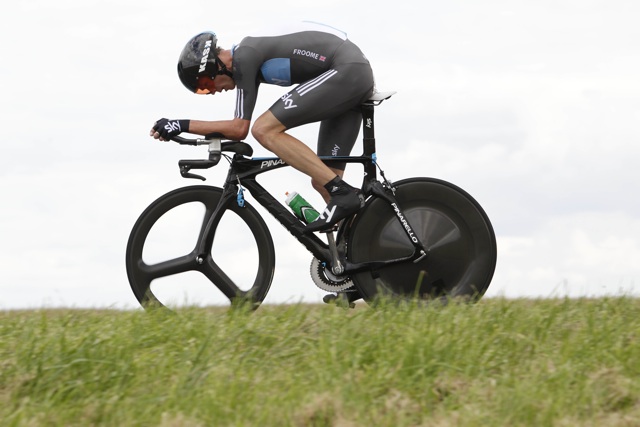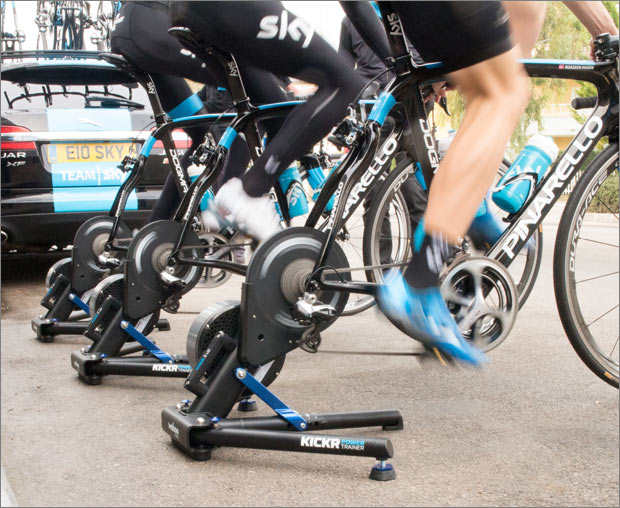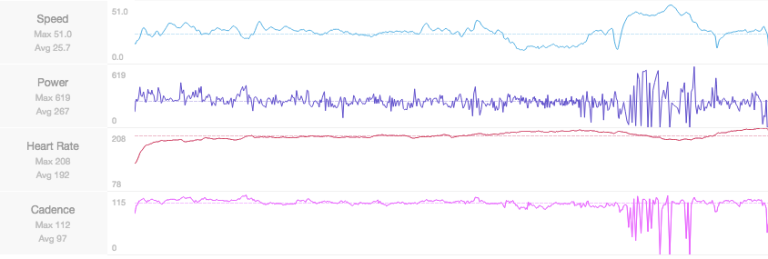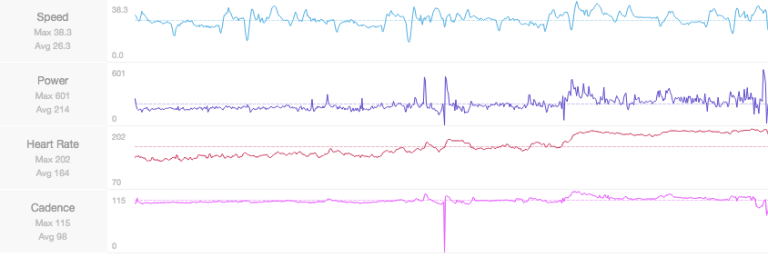Training for many sports requires expensive kit – A kayak for a kayaker, a set of golf clubs for a golfer. Cycling is undoubtedly one of the more expensive sports out there – The idea of owning n+1 bikes is instinctive for most cycling enthusiasts.
In most cases, a purchase has been made to improve performance. From purchasing a heart rate monitor, to a more aerodynamic helmet, the list of marginal gains from products is large. Nevertheless, there are 2 desirable products that will assist training, and create more-satisfying results: A power meter, and a smart trainer. Both are expensive, and so you must think greatly before making a final decision. Which is better?
Power meters – The game changer
Observing your average speed can only tell you so much about a ride. A heart rate monitor can tell you a little more, but this piece of technology itself can be influenced by factors such as illness, outdoor temperature, and levels of fatigue.
A power meter is a quantitative, reliable and repeatable way to analyse the intensity of a ride. Illustrating the power (presented in watts) you exert, most power meters will be located in the pedals, rear hub or cranks of a bike. A power meter works by multiplying force by velocity (power = force x velocity) – The force is calculated from strain gauges within the power meter, and the angular velocity is taken into account. From these two figures, the power output can be calculated.
I personally use a Garmin Vector power meter, and they are fantastic 🙂
Benefits of a power meter:
- Provides quantitative data, that alongside a heart rate trace, can exhibit an increase or decrease in fitness, form and fatigue.
- Provides insightful knowledge that will help to maintain (pace) an effort during an event. For example, in training, you are able to hold 400 watts for 5 minutes (before blowing up and collapsing to the floor in an explosion). In a race, you know that if you constantly exceed 400 watts, you will not be able to continue riding for 5 minutes.
- The data can also be utilised to produce specific training sessions that will improve performance at a greater rate than other products, such as a heart rate monitor.
- Greater indication of the true intensity of effort than RPE (Rated Perceived Exertion) and figures form a heart rate monitor, as less factors influence readings projected from a power meter.
- Power meters can be used when riding outside and inside – Smart trainers are confined to the indoors.
Limitations of a power meter:
- Cost – Purchasing a power meter is costly to most (unless you are Bill Gates). Power meters can be purchased for as little as £300, however most power meters feature a price tag that shifts more towards the £1,000 mark.
- Margin of error – Most power meters project a margin of error that is around 2%, however the likelihood is this figure is lower with more renowned, major corporations such as Garmin. Consequently, they are more expensive.
- You need to be able to interpret the data – Simply owning a power meter will not make you a pro. You need to be able to analyse and understand the numbers streaming from your power meter to improve yourself. I use Strava, and Golden Cheetah, to analyse my ride in great depth.
- Keep your eyes on the road! Chris Froome probably spends half his time looking forward whilst riding, and the other half looking down at his power meter! Make sure to maintain awareness of your surroundings whilst riding 🙂

Smart trainers – Are they better for training than power meters?
Riding outside is great, especially when the weather is in your favour. However, these days are pretty rare, and are essentially fantasised during the winter months. The cold, dark, rainy and windy weather is not only grim, but can also be detrimental to your health and safety too.

In these circumstances, training indoors is the most sensible option.
The most noticeable advantage smart trainers have over power meters in the realm of training, is the variable resistance according to the gear you are in, and/or the virtual road gradient in virtual-world applications such as Zwift.
A smart turbo trainer features computer control and either Bluetooth or ANT+ connectivity. Devices such as your phone and tablet, speed and cadence sensors can be paired with your smart trainer. A power measurement will be produced by the smart trainer, to varying degrees of accuracy.
Training with a smart trainer
I often use a smart trainer when training inside – The fluctuating resistance, due to the road gradient in applications like Zwift, greatly mimics the resistance I would encounter if I were riding outside and provides a realistic experience. The smart trainer effortlessly turns up the resistance as I ascend, and decreases the resistance as I descend. I personally use a Wahoo Kickr Smart Turbo Trainer, and it is fantastic.
Benefits of a smart trainer:
- Realistic varying resistance – The resistance present can fluctuate depending on the gear you are in, and/or the virtual road gradient in virtual-world applications such as Zwift.
- Calculated power output – A smart trainer features some kind of power measurement, providing quantitative data that can be analysed to produce specific training sessions.
- Can simulate the exact course of your race – You are able to upload racecourse .GPX files and ride the course – Reconnaissance has never been easier.
- ERG mode – This mode will set your trainer’s resistance for you rather than leaving that responsibility on your shoulders. Using such modulation will help to produce a smoother, more consistent power output during efforts.
- No stupid car drivers to deal with – A real advantage.
Limitations of a smart trainer:
- Cost – The cost of smart trainers can vary from £300 to as much as £1,000 (same price range as a power meter).
- Can not be used when riding outside – By this, I mean riding along a road. A smart trainer is static, and so often remains indoors.
- Margin of error – The margin of error with smart trainers is approximately the same as that of power meters, maybe a little greater.
- Weight and size – Smart trainers weigh SIGNIFICANTLY more than power meters, and are much larger too.

As I have already mentioned, smart trainers calculate your power output. However, how do power readings from a smart trainer compare to that of a power meter? I have conducted a series of tests to answer this:
I tested both products at the same time, by riding on a smart trainer with a power meter. I then synced the power meter to one laptop, and the ‘smart trainer power’ to another laptop. For this I needed two Zwift accounts, and so I used my dads. We have different weights (trust me, we do :D), and so the speed of the avatars would not be the same (ignore the speed traces).
In these tests, we are comparing the power traces.
Test 1: KISS (A) Team Time Trial
Smart trainer: Analysis
The data below was produced using a Wahoo Kickr smart trainer. With the in-built power meter, I produced an average of 267 watts (4.45w/kg), and an average cadence of 97rpm.The power trace (the purple line) illustrates a relatively even power output, apart from some fluctuation towards the end, whilst descending (short bursts in an attempt to stay with my heavier teammates downhill).

Power meter: Analysis
The data below was produced using Garmin Vector power meters. With the power meter, I produced an average of 272 watts (4.53w/kg), and an average cadence of 95rpm. The power trace illustrates a comparatively similar even power output, however the power spikes in the early stages of the race are more noticeable with this data in comparison to the smart trainer data. The difference in the power readings between both products is 1.87% – a feasible figure, remembering the 2% margin of error. In addition to power, the cadence trace (the pink line) for the power meter is ‘smoother’ than the smart trainer – This has most likely resulted form the varying resistance applied by the smart trainer, in correlation to the varying virtual gradient in Zwift. Furthermore, the heart rate trace (the red line) is also smoother with the power meter in comparison to the smart trainer, likely for the same reason.

Test 1 – Conclusion
From this effort, I can conclude that the power meter produces a more consistent, level This is due to the frequency of data collection. Both products illustrate similar increases and decreases in power output at the same given point.
Test 2: USS (U.S. Sunday Spin) Group ride
The USS group rides are weekly group rides that take place on Sunday, beginning at 17:00 GMT. I decided to test both products in a group ride, to see how both products compare when used in a general ride.
Power meter: Analysis
The data below was produced using Garmin Vectors. As you can clearly see, I put in a relatively big effort with around a third of the ride to go. I was breaking away with a few other guys, and rode hard for a lap and a quarter, sprinting to 2nd place in the finishing sprint 🙂
Averaging 214 watts (3.56w/kg), my average cadence with the power meter was 98rpm.

Smart trainer: Analysis
The data below was produced using a Wahoo Kickr smart trainer. According to this data from the Kickr, I produced 221 watts in comparison to the 214 watts illustrated by the Vectors (a 3.27%). As you can see, the power surges/spikes on both graphs coincide with each other, and both present essentially the same heart rate and cadence traces.

Zwift – How it has revolutionised my training
Zwift, a virtual-world application, has enabled me to train during the bitterness of winter. A social yet competitive environment, Zwift had presented not only an opportunity to maintain high levels of fitness without the risk of illness and injury, but to strengthen myself for the upcoming season of racing. Alongside the use of a smart trainer, I was able to really progress physically. The social environment drastically reduced the tedious nature of indoor training, as I often competed in virtual races against other riders, from all over the world.
Conclusion
It is difficult to state which training tool is the most effective in terms of training: both have advantages and disadvantages in relation to each other. Although smart trainers boast noticeable benefits to training, power meters provide greater value for money. In addition to their use outside, power meters can be used on a range of trainers – From turbo to rollers, the range of uses a power meter has to offer is undeniably impressive.
I have come to the conclusion that power meters and smart trainers are equally effective and useful when it comes to training; both offer numerous advantages to the user. However, power meters can be used outside, and I see them in a sense as being more ‘trustworthy and precise’, when recording power, in comparison to smart trainers, simply because that is their sole purpose.
Most people train to improve their performance in real life. A power meter will measure your performance in training, and in real-life races. A smart trainer can’t do the latter. Consequently, you will only end up with real-life race data when using a power meter. This will allow you to analyse and scrutinise your performance in that race, and will assist your specific workouts and training plan just a little more.
Thanks for reading 🙂

Hello Chris,
How can reach you in email about your article? or can you reach out to me at tariqhali at gmail?
thanks!
LikeLiked by 2 people
Great article. Thanks. I have conducted similar tests using both Garmin Vector and Wahoo Kickr. For some reason my Kickr seems to consistently register 10-12 % higher than my Vectors.
LikeLiked by 1 person
Do you have any experience using zwift on a regular indoor trainer and power meter?
LikeLiked by 1 person
Yes, I’ve done 10,000+ miles on a regular trainer with a power meter.
LikeLike